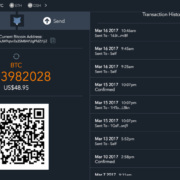The Basics of Blockchain Technology and Token Sales
With over half a trillion dollars now invested in more than a thousand cryptocurrencies and blockchain projects, everyone should have a least a basic understanding of the mechanics of what many are calling the web 3.0.
Initial Coin Offerings (ICOs)
One of the first big applications of blockchain technology is the ICO or “Token Sale,” which is a new way to raise capital that is disrupting traditional fundraising methods. With ICOs suddenly outpacing traditional venture capital funding by raising almost $4 billion in 2017, startups and investors around the world are taking note.
An ICO is often compared to an Initial Public Offering (IPO). The main feature that gives the ICO both greater potential for raising money and higher risk/reward for investors is that it allows a wider range of investors to gain earlier access to the investment opportunity. In the traditional model, by the time a company has made it to the IPO stage, it has already been heavily invested in by a small pool of connected venture capitalists and “angel investors.” Additionally, when the public offering is finally made, it is typically only available to retail investors who have access to the specific market it is available on (such as the NASDAQ). ICOs, however, can be made available to anyone anywhere, and contributions could theoretically be less than $1 each. With this kind of ease of access to investment, ICOs with little more than a website and a whitepaper have raised millions of dollars.
The first ICO was in 2014 but it wasn’t until 2017 that ICOs exploded in popularity. 2017 saw more than 10 times as much raised through ICOs as 2016. Out of the 25 highest crowd-funded projects of all time, 18 of them are blockchain companies.
Blockchain Technology’s Connection to the ICO
The secure transaction of information across a distributed network of computers is possible because of “asymmetric encryption” a concept developed in the 1970s. This, along with peer-to-peer networking and distributed computing, combines to enable blockchain functionality.
The development of blockchain technology effectively solved the “double-spending problem” thereby enabling a safe peer-to-peer payment system. Double-spending is the digital version of counterfeiting currency. Blockchain transactions are logged sequentially in an immutable and slowly growing chain that is recorded on all of the “nodes” in the network (nodes are essentially computers that store and process transactions).
With counterfeiting eliminated in a peer-to-peer transaction, it is now possible to record transactions without the need for a “trusted” centralized authority to confirm that they are correct. This means that tokens issued in an ICO can be safely purchased by anyone with access to the rapidly growing cryptocurrency ecosystem.
What is the Token for?
A typical ICO offers tokens in return for currency invested. The token can represent some sort of value or be of value itself. Tokens that represent value are typically called cryptocurrencies, with Bitcoin being the biggest example.The other way tokens are used is to power some form of functionality in the network. In the case of Ethereum, the Ether token is used to pay for the execution of smart contracts.
What Else Can Blockchain Do?
The power of blockchain technology lies in its decentralized and distributed “trustless” network which provides not only security, but also allows “perfect” economic behavior. Many blockchain projects are essentially designing new socio-economic systems that are built to incentivize positive behavior and unlock potential growth.
Imagine, for example, a decentralized version of Youtube:
Instead of the uploaded content being stored and indexed on centralized servers which act as gatekeepers, it would be stored on a decentralized network of computers operated by anyone, anywhere in the world. These people would be incentivized to use their computing power and storage space by offering them an economic reward, or token, which would become the currency of the network. People who watch content on the network would pay for it either by purchasing tokens or exposing themselves to advertising (advertisers would then be buying the tokens). Anyone who uploaded content to the network would be the owner of that content, and would receive all royalties minus the costs to run the network.
What Are the Advantages of This System?
In this system, there is no owner of the network so there is no middleman taking a share of the profits. There is also no chance of censorship. Once the information is uploaded and agreed upon as correct by the consensus rules of the protocol, it becomes immutable because it is spread across computers all over the world. Making any changes would require agreement by everyone involved. Decentralized applications, therefore, eliminate the need for profit-taking middlemen while increasing users’ freedom, rights, and security.
Decentralized applications allow the true power of economic incentive to be unleashed. Instead of a centralized authority taking a significant portion of the value, individuals get a bigger share based on the value they bring. Individuals are therefore more incentivized to bring value to the platform than through an equivalent centralized platform. The result should be an overall increase in value.
What Kinds of Decentralized Applications Can Exist?
People are working on applications to decentralize everything from ride-sharing apps to home mortgages. There are decentralized projects that enable content sharing, cloud computing, real estate transactions, and of course value exchange.
Can a Decentralized Blockchain Based Project Make Money for Its Creators?
Most of the proposed use-cases for blockchain projects will disrupt centralized industries. The point is to generate value, but not necessarily for the people who created the network. Most projects, therefore, reserve for themselves a significant portion of the tokens produced. These tokens are sometimes locked up until certain objectives in the development roadmap have been reached. If all goes well, the builders of the project should be able to profit by holding tokens that grow in value as the value of the network grows. Project builders are of course also well positioned to profit from the economics of the system they create. They can, for example, “mine” tokens themselves or otherwise participate in the network they have created.
Have questions about the Token sale? Post them in the comments, we are here for you.




